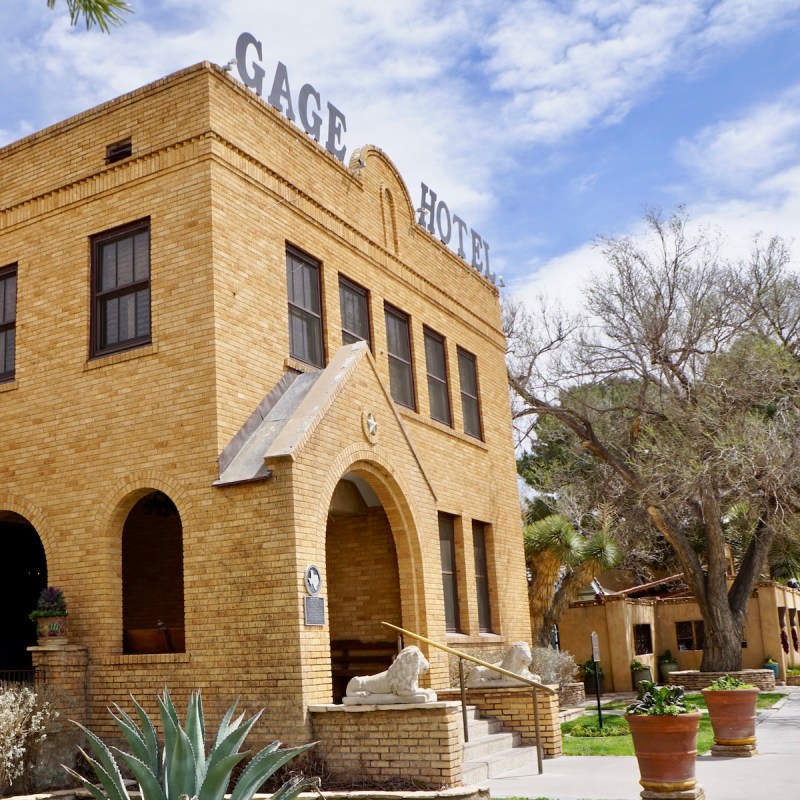
A prominent West Texas architect, a Great Depression-era work program, and local cattle ranchers — they all left their mark on the string of cool little hotels that dot the landscape of the southwest-Texas region known as Big Bend Country.
Videos by TravelAwaits
In this remote corner of Texas near the spectacular Big Bend National Park, explorers will discover treasures like a white-walled lodge created by the young men of the Civilian Conservation Corps; the shady courtyards and graceful arches of hotels designed by early-20th-century architect Henry Trost; and accommodations that originated as a retreat for the “Summer Swallows” who flocked to the Davis Mountains for its cool summer weather.
Regardless of the history, though, the modern-day reality is that remarkable stays are in store for those traveling the scenic ranchland and big, blue skies of West Texas.
One of the beauties of the region’s historic hotels is that many are located within a few hours of one another, making for a convenient road trip. On my two recent drives through West Texas, I found the combination of fascinating Texas ranching stories and the hotels’ luxurious touches hard to resist.
Here are six incredible historic hotels in Texas’s Big Bend Country.

1. Hotel El Capitan, Van Horn
The most accessible of the quartet of Trost hotels operating in Big Bend Country, the Hotel El Capitan is located a block or two off Interstate 10 in Van Horn, along the route between El Paso and major Texas cities to the east, including Austin and San Antonio.
El Capitan was built in 1930, a design of Henry Trost, the El Paso architect behind more than 550 buildings from Texas to California in the early 1900s. Occupying a prominent spot on the main street of Van Horn, El Capitan is known as a stopping-off point for people traveling between Texas’s two national parks, Guadalupe Mountains National Park to the north and Big Bend National Park to the south.
The first thing I loved about El Capitan was the shady courtyard that fronts the hotel’s entrance. When I arrived after a long day of driving, I was met with the sweet sound of running water from the fountain that sits in the center of the small courtyard.
El Capitan’s lobby is also distinctive, with its European-style tile and log-beamed ceiling. The hotel has 49 rooms, and 12 of them have French doors that open onto small balconies that overlook the courtyard.
The adjoining El Capitan Restaurant and Gopher Hole Bar is a popular establishment in Van Horn, so it’s advisable to ask about a time for dinner or lunch when checking in. House favorites include Texas classics like the pistachio fried steak, the 14-ounce hand-cut ribeye, and the homemade pecan pie.
Pro Tip: Van Horn is a railroad town, and the El Capitan is located right across the street from the train tracks. Guests should expect some train noise throughout the evening and night. Although the passing trains didn’t interrupt my sleep, I was told that light sleepers sometimes were awoken by the sound.

2. The Gage Hotel, Marathon
As the closest hotel to Big Bend National Park, Marathon’s Gage Hotel has long offered a bit of luxury for guests heading to the rugged trails of the national park. The hotel dates back 95 years, and it is known as a spot for laid-back luxury and gracious hospitality, as well as the home of one of the most iconic bars in Texas.
Back in the 1920s, early West Texas pioneer Alfred S. Gage decided the little town of Marathon needed a hotel to serve as a base for overseeing his ranching operation, the hotel’s website says. He commissioned Henry Trost to design it, and The Gage Hotel was born in 1927 — “an excellent example of Mission and Spanish-style design.”
Even if you don’t stay at the Gage, I recommend walking through the grounds to take in the lovely aura of Lone Star chic and having lunch or dinner at one of the excellent dining establishments. The hotel is a part of a complex of businesses that includes the 12-Gauge Restaurant, the V6 Coffee Bar, the Brick Vault Restaurant & Brewery, and the White Buffalo Bar.
Named one of Texas’s best hotel bars by Texas Monthly Magazine, the White Buffalo offers a large assortment of tequilas and fresh-squeezed margaritas, as well as bar bites like chicken fried steak with cracked pepper cream gravy or cornmeal-fried oysters with garlic aioli and habanero salsa.

3. The Holland Hotel, Alpine
The original Holland Hotel was built by prominent Alpine cattleman JR Holland in 1912, and within a decade and a half, an even grander version was built by Holland’s son Clay, who commissioned the Trost’s architectural firm to do the design.
Over the past 94 years, the Holland Hotel has experienced a number of transformations and ownership changes. It was converted to an office building in the 1970s, before being converted back to a hotel in the mid-1980s. In 2012, it was acquired by Greenwich Hospitality, which continues the process of restoration.

Today, the hotel serves as a “ranch and rail” centerpiece of bustling downtown Alpine, right across the street from the Amtrak station where passengers have been boarding the iconic Sunset Limited rail line since 1928.
The Holland has 27 luxury guest rooms and suites decorated in a Southwestern-inspired motif. It also features a beautifully restored main lobby and courtyard area, as well as the Century Bar & Grill, which serves up contemporary cuisine steeped in history.

4. Hotel Paisano, Marfa
Although the groundbreaking for the Hotel Paisano in Marfa, Texas occurred in October 1929 just a few days before the stock market crash that brought on the Great Depression, that unfortunate bit of timing did nothing to detract from the charisma of the hotel.
Construction continued, and the Paisano opened for business in June 1930, becoming known as “the most elegant hotel between El Paso and San Antonio.” Located in the heart of the ranching and artist town of Marfa, the Hotel Paisano has long served as a social hub for the area.
The Paisano’s star power was greatly magnified in 1955, when Warner Brothers came to Marfa to film the star-studded movie Giant and chose the Paisano as its headquarters. The movie starred Elizabeth Taylor, Rock Hudson, and James Dean and included 150 other cast members and crew, who made the Hotel Paisano their gathering place for 6 weeks that summer. A large memorabilia room in the hotel offers a glimpse into that movie extravaganza.
After changing hands several times over the decades and falling into disrepair for a time in the early 2000s, the Hotel Paisano was rejuvenated and today is completely renovated with 41 rooms and suites. “The Hotel Paisano is once again a destination in West Texas,” the hotel’s website boasts.
Along with its elegant lodging, the Paisano has a seasonally heated pool, an extensive gift shop and art gallery, and a casual restaurant and lounge, Jett’s Grill, with courtyard seating.
The Paisano is the perfect place to indulge in a bit of Hollywood glamor while exploring Big Bend Country.

5. Indian Lodge, Fort Davis
For a step into another era, a trip through West Texas should also include a stop at the Indian Lodge, a little oasis set in the midst of the rugged Davis Mountains. Along with its pueblo-style walls that glow in the sunlight, the Indian Lodge stands out for its fascinating history. Developed in the midst of the Great Depression of the 1930s, the lodge was built by companies of the Civilian Conservation Corps (CCC), the program that put unemployed young men to work during the depression.
The state park’s website notes that two CCC companies molded adobe blocks from a mixture of water, straw, and soil, “and muscled tens of thousands of 40-pound blocks into place to form the 12-to-18-inch-thick walls, several of which rise as high as three stories.”
More than eight decades later, the Indian Lodge offers rustic but comfortable lodging in Davis Mountains State Park. The lodge’s interior features hand-hewn pine beams and furniture, and the outdoor area offers a quaint courtyard with a refreshing swimming pool overlooking the mountain terrain.
I found the Indian Lodge to be a wonderful base for exploring the scenic state park and the quaint town of Fort Davis. The lodge has 39 rooms, many of which open out onto the courtyard’s seating areas.
Pro Tip: The lodge’s in-house diner, the Black Bear Restaurant, is open for breakfast and dinner Wednesday through Sunday.

6. Hotel Limpia, Fort Davis
Back in 1912, when the Hotel Limpia was built in the mile-high Texas town of Fort Davis, the little pink-stone hotel was known as a popular destination for “Summer Swallows” — the out-of-town visitors who arrived in time for the cool summer climate that Fort Davis and the surrounding Davis Mountains had to offer.
Now, 110 years later, the charming Victorian-style hotel still attracts visitors looking for the cool breezes of the Davis Mountains. Located in the middle of downtown Fort Davis, the Limpia offers easy access not just to the hotel’s courtyard garden, glassed-in veranda, and tranquil porches, but also to the numerous restaurants and shops that line the streets of Fort Davis.
It also is near the Fort Davis National Historic Site, one of the best-preserved examples of a frontier military post in the southwestern U.S.
Pro Tip
Located within a 5-hour, 30-minute drive from Big Bend National Park is the major West Texas city of El Paso, which is known to have a number of wonderful historic hotels of its own. The best known is the luxury Hotel Paso Del Norte, Autograph Collection, a 1912 creation of the Trost & Trost architectural firm. For other El Paso gems, see 5 Unique Stays In El Paso, Texas.
Further Reading:

